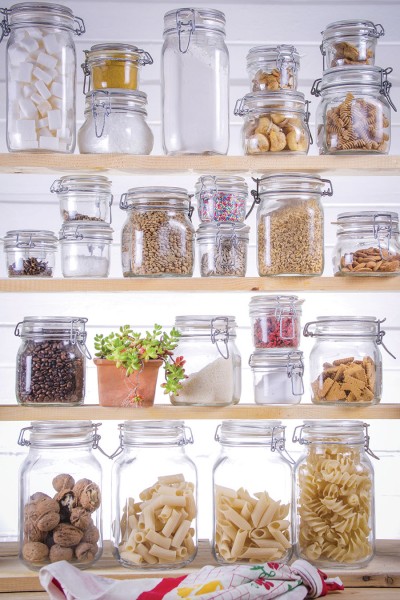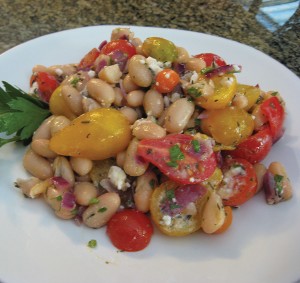 The secret to being a good home cook is having a well-stocked pantry. This doesn’t mean having everything under the sun in your pantry (and never using half of it). It means having key items on hand to be able to create a delicious meal on a whim.
The secret to being a good home cook is having a well-stocked pantry. This doesn’t mean having everything under the sun in your pantry (and never using half of it). It means having key items on hand to be able to create a delicious meal on a whim.
Most of us are busy and may not even think about dinner until it’s time to prepare it. If you have the right stuff on hand, you’ll be able to make a tasty and nutritious meal you feel good about.
Here are some tips for organizing a successful home kitchen stocked with items that can be found at most grocery stores, starting from the beginning:
Meal Planning
Some people plan every meal of the week, while others plan as they go, even shopping on a daily basis. A good rule of thumb is to plan for three to four meals you know you’ll have time to prepare and cook, allowing for flexibility if time falls short or you change your mind.
Grocery Shopping
The most important tip is to make a shopping list! Because we’re so busy, or may have little ones trailing us in the store, it’s essential to have everything we need written down. In my experience, if it’s not written down it’s almost guaranteed something will be forgotten. Having a list helps ensure we buy only what’s needed and avoid buying items we already have. Trust me; you will save time, money and your sanity by having a list.
If you keep your pantry well-stocked with essentials, your grocery shopping will consist of mainly fresh food items for the meals you plan to prepare. Always try to buy produce in season. It’s fresher, more nutrient dense, and typically has travelled fewer miles to get to the store. If you are not sure what’s in season, ask your store’s produce manager or look for items that are on special or stocked plentifully.
There are a plethora of meal-planning templates available online, including a creative array at TipJunkie.com that include free templates for weekly and monthly meals, grocery lists, and even a “pick your lunch” form for the kiddos, all found at http://www.tipjunkie.com/post/meal-planner
Stocking Your Pantry
What you like to cook will determine your essential pantry items. If you want to eat healthier, don’t fall prey to buying prepackaged and canned meals. Some of the suggestions below are packaged or canned, but the majority of your family’s meals should use fresh ingredients whenever possible.
Herbs & Spices: This is one of the most important aspects of stocking your pantry and cooking. Always remember, the better the quality, the better the taste. Generally, the pricier herbs and spices are fresher and taste better. You don’t need every spice in the world on hand, just the ones you use the most or that are versatile.
My favorite dried herbs: oregano, thyme, dill, sage, herbs de Provence and dulse flakes (dulse is a sea vegetable-high in minerals and trace minerals).
My favorite spices: Himalayan salt (high in minerals and trace minerals), cumin, coriander, paprika, turmeric, garlic powder, white pepper, mixed peppercorns, cayenne, celery salt, ginger, cinnamon and cardamom.
Oils &Vinegars: The types of oils and vinegars you choose can add a special zing to your food and bring out flavors, and can play a role in boosting overall health.
Baking and Cooking Oils: extra virgin olive, coconut, avocado, canola (organic), safflower, sesame, sunflower, grape seed.
Oils for Salad Dressings: flax seed, hemp, avocado and extra virgin olive.
Vinegars: apple cider (unfiltered and raw), coconut, rice and balsamic.
Tip: purchasing or storing oils in dark glass bottles helps preserve freshness.
Other Pantry Essentials: There are a few items that are a must for providing a great base for whatever you are making. Purchase quality ingredients and look for canned food items that are BPA free.
- Beans & Legumes: Beans are high in dietary fiber and protein, are low on the glycemic index, and they contain an abundance of minerals and trace minerals essential for health. The healthiest option is to cook your own beans (a crockpot works well for the task), but canned beans are convenient. A variety of whole beans, lentils and refried beans can make a quick meal or component of a meal. See recipe on page 17 for a delicious, nutrient dense bean salad.
- Whole Grains and Pastas: These can be challenging for individuals who are intolerant or allergic to grains or gluten, or on a Paleo diet. In that case, feel free to avoid this category. However, there are alternatives to wheat and gluten products, and by choosing wisely, more often than not you can improve your health while you’re at it. Gluten-free pasta is a great place to start. Follow cooking instructions carefully … do not over-cook and always rinse cooked pasta well to prevent a sticky texture. Don’t be afraid to experiment; there are many choices available in grocery stores.
- Grains: Health-wise, it’s always better to choose grains in their whole state over refined grains. I suggest having a variety of rice on hand (brown, basmati, red, black, wild, etc.) as it is generally well tolerated by gluten-sensitive individuals. Quinoa is a lovely grain that is actually a seed; it’s a complete protein and full of nutrients. Cooked correctly, quinoa is a delicious compliment to any dish. Oats can be used in a variety of ways; besides a steamy bowl of hot oatmeal on a cold day, oats can be used to thicken vegan soups, added to cookies to make them more nutrient dense, and added in meatloaf or meatballs as an alternative to breadcrumbs. Other staple grains include barley, millet, amaranth and faro.
- Flours: Look for the least refined varieties. I usually have unbleached flour, whole wheat flour and a gluten free baking mix on hand, and alternate between them depending upon what I’m making.
- Tomatoes and Tomato Sauce: These are essential in a well-stocked kitchen. If you have access to fresh tomatoes, use those. Canning, drying or freezing your own tomatoes/tomato sauces for winter use is always great. If that’s not possible, try to keep a variety of tomato products (organic is best) on hand as these make a good base for many dishes.
- Chicken, Vegetable and Beef Stock: You can’t beat having a good soup stock on hand. If you can make home-made stock, great, but for times you don’t have any on hand, try organic boxed stock, stock powder (often available in the bulk section of natural foods stores), or stock cubes (add hot water to make). Look for low-sodium varieties that put you in charge of the sodium content of your meals.
- Wild Fish: Salmon, tuna, sardines and anchovies are not only high in protein, they contain essential fatty acids, minerals and trace minerals. Having a variety of canned wild fish on hand means variety in your diet. Use tuna sparingly as it’s known to contain high levels of heavy metals; try to purchase pole caught tuna as these tend to be younger with lower concentration of heavy metals in their systems.
- Nuts and Seeds: Best purchased in their raw form, nuts and seeds are highly nutritious, containing healthy fats, minerals and trace minerals, plus plenty of dietary fiber. Great in baking, on salads, and sprinkled on sautéed vegetables.
- Sugar and Sweeteners: Find alternatives to refined white sugar, such as turbinado, sucanat, pure maple syrup, raw agave and local raw honey. Learn to use these healthier alternatives in recipes. Also look for stevia – it has zero effect on blood sugar levels without causing harm to the body in other ways.
- Produce Staples: Meals can come alive simply by adding fresh onions, garlic, ginger, lemon or lime. I make sure I have these items on hand and use them in just about everything. I also keep potatoes & sweet potatoes stocked year-round as an alternative to pasta or grains.
Refrigerator Staples: These are dependent upon the season and preferred taste, but easy quick items may include omega-3 eggs, low-fat cottage cheese and yogurt, fresh herbs, salad fixings, olives, a variety of fresh produce, mustard and non-GMO mayonnaise.
Storage Tips: Storing grains, flour, nuts and seeds in the freezer extends their shelf-life and helps prevent them from going rancid or acquiring weevils, especially in warm climates and seasons. These items can be stored in mason jars or other tight-sealing containers.
Be careful not to fall victim to the over-packed, out-of-date pantry, and always remember to make a grocery list. Soon you’ll be on your way to successful shopping and successful cooking!
This salad is not only delicious, it’s highly nutritious. Beans contain minerals and protein and are high in fiber, making them heart-healthy and essential for maintaining blood sugar levels. Lemon and parsley help cleanse kidneys, liver and blood. Thyme contains antioxidants, and garlic, amongst the many health benefits it offers, helps maintain healthy cholesterol levels. The addition of feta cheese makes this salad a complete protein.
Ingredients
- 2 cans (3-4 cups) cooked white beans, rinsed & drained
- ½ medium-sized red onion, diced
- 1 cup cherry tomatoes, halved
- 2 garlic cloves, diced
- ¼ cup fresh parsley, finely chopped
- 1 tsp dried thyme or 2 tsp fresh
- ½ fresh lemon, juiced
- 2 capfuls raw apple cider vinegar
- 1 Tbsp mustard
- 1-2 Tbsp olive oil
- ½ cup feta cheese
- salt and pepper to taste
Mix all ingredients together in a bowl.
Serve at room temperature.
Posted in: Health & Nutrition
Comment Policy: All viewpoints are welcome, but comments should remain relevant. Personal attacks, profanity, and aggressive behavior are not allowed. No spam, advertising, or promoting of products/services. Please, only use your real name and limit the amount of links submitted in your comment.
Trackbacks
Leave a Reply
You Might Also Like...
My Mother Hid Her Cancer Diagnosis from Me – I Made a Different Choice with My Own Children
In the summer of 1998, I returned home after a yearlong college study abroad program. One day as my mother and I were catching up, the conversation took an odd […]

Covered California: What You Need To Know About The New Healthcare Marketplace
According to the California Healthcare Foundation’s 2012 annual report entitled “California’s Uninsured: Treading Water,” in 2011 nearly 7.1 million people under the age of 65 were not covered by health […]

Does Your Smile Need A Fix? Orthodontists Aren’t Just For Kids!
As a child, Tina McDermott received dental advice that was commonly given in the ‘80s. “My teeth weren’t horribly crooked,” she says, “so my dentist told my mom that I […]

Choosing a Pediatrician
Your relationship with your child’s pediatrician is one of the longest associations you’ll have in your lifetime. For one child, it’s a connection that’s likely to last 18 to 21 […]





[…] northstateparent.com/article/the-well-stocked-pantry-for-a-successful-cooking-experience/ […]